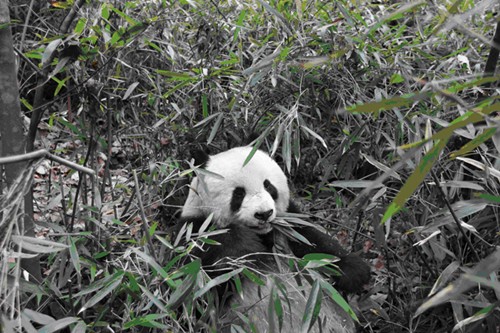Executive summary:
The giant panda has exceptionally low daily energy expenditure allowing it to survive on its bamboo diet. The low expenditure is linked to low levels of physical activity and low levels of thyroid hormones probably caused by a genetic mutation in the thyroid hormone production pathway.
Main text
The giant panda is a critically endangered bear, found only in China. In the wild there are less than 2000 left. The panda is famous for being a meat eater that has become a vegetarian. In the wild its diet consists almost entirely of bamboo. However, while its diet has changed, its guts remain essentially designed for digesting meat, and that causes the panda a big problem because bamboo is not easy to digest, and so pandas have to eat lots of it to survive (up to 50lbs a day!).
To enable pandas to make an energy balance scientists have long suspected that they must have low metabolic rates, but until now nobody has managed to measure the pandas metabolism. A collaboration between scientists at the Chinese Academy of Sciences (CAS), Beijing Zoo and the University of Aberdeen, led by Professor Fuwen Wei of the CAS Institute of Zoology in Beijing, published today in Science, has now made these measurements in both captive and free-living pandas. It turns out that the metabolism of the panda is incredibly low – around the same level as that of the sloth. We often think of humans as having low metabolic rates, but a 90kg panda expends less than half the energy of an equivalent weight human.
How do they achieve such low metabolic rates? There are several contributory factors. If you ever went to see a panda in the zoo then you will know that they are not the most exciting of creatures. Pandas save a lot of energy by being really frugal in the energy they spend on physical activity. In the wild the study in Science showed, using GPS loggers attached to free-ranging pandas, that pandas rested for more than half of the day and on average they travel just 20 metres (22 yards) per hour!
But low activity is only half the story. The metabolic rate of an ‘active’ panda is even lower than a completely stationary human. The secret to the low metabolism of the panda, the study in Science showed, is that they have very low levels of thyroid hormones, probably linked to a unique genetic mutation in a gene that is critical for thyroid hormone synthesis. This may be instrumental in lowering not only their activity, but also their metabolism when they are resting.
One problem with having such a low metabolic rate is how the Panda manages to keep warm. The answer lies in the pandas exceptionally thick fur which traps their meagre body heat inside. This means the surface temperatures of pandas, measured using a thermal camera, are much lower than other black and white animals like zebras and Dalmatian dogs. In other words pandas are literally COOL!
The study was funded by the National Science Foundation of China and the Chinese Academy of Sciences.
Reference: Nie et al. (2015) Exceptionally low daily energy expenditure in the bamboo eating giant panda. Science DOI: 10.1126/science.aab2413

Thermal image of giant panda (Yonggang Nie)

Wild panda in the Foping Nature Reserve eating bamboo (Fuwen Wei)


